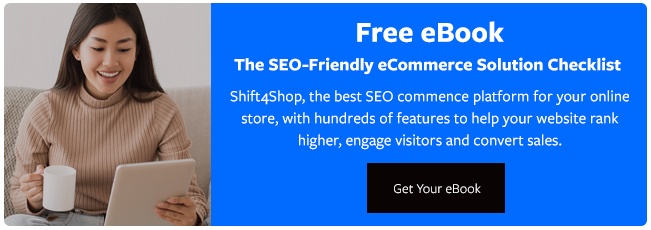
The internet is a noisy place. How does your online store stand out from the competition?
We frequently see online stores grapple with the discovery phase of marketing their websites. It can take time for your store to gain enough traction for potential customers to find you. A little patience can go a long way for your store. That and a whole lot of optimization. If you find drawing in customers is taking too long, you might be committing some of the cardinal SEO sins, and you’ll want to take action to fix them ASAP.
Search engine optimization (SEO) is a critical focus for online retailers, especially in the early stages of business. Your ecommerce SEO strategy ensures shoppers who hit Google looking for your products find your store right away, rather than one of your competitors. It’s a widely misunderstood marketing practice in the ecommerce world because search engines tend to be tight-lipped about how their algorithms work.
We know enough, however, to make a huge difference in how online retailers market their businesses. Missteps can hurt your website just as much as good SEO can help it. Making sure your ecommerce website’s SEO hasn’t fallen by the wayside is critical to your business. The first step to good SEO is checking your online store for these common problems.
Problem 1: Targeting the wrong keywords
One of the fundamental elements of a strong SEO strategy is choosing the right keywords. What words and phrases will potential customers use to find your online store?
When you first get up and running with SEO strategies and plugins, it’s tempting to jump in headfirst and target a handful of words that spring out of a brainstorm -- and, in fact, this is how lots of online retailers tend to approach the problem.
Brainstorming is important. You need a seed list of keywords to get your SEO up and running. But it’s just the tip of the iceberg when it comes to creating a definitive list of target words and phrases. To truly address the problem, you’ll want to:
- Research keywords your audience actually use on Google and other search engines
- Find out which words your competitors are targeting
- Hone in on keywords and phrases that aren’t “owned” by other websites where you could rank well with minimal effort
These are just a few ways to get your store on the path to keyword enlightenment.
Problem 2: Slow site speed
Does your online store load instantaneously? Does it take one second to load? Two seconds? If it takes three seconds or more, you can bet impatient shoppers are going to jump ship and go somewhere else to buy.
After customers find your site, speed is crucial for keeping them engaged. It’s also a huge factor for SEO. When someone finds you through search, the search engine knows how long it takes to load and whether or not that person sticks around or abandons your site immediately. This plays a factor in how your site ranks for your keywords.
With lots of products, pages, and images, ecommerce websites can quickly bloat into slow-moving behemoths, dragging down your searchability in their wake. To help with SEO, work with your website provider on ways you can increase your page load speed.
Problem 3: Confusing architecture
Once again, your website’s usability comes into play when it comes to SEO. The structure of your site plays an important role in how your customers get from start to finish in the purchase process. Site architecture also optimizes search engine crawling, which means better indexing.
Think of your site’s page structure as a foundation for strong SEO performance. A poor architecture makes it very difficult to excel in SEO, no matter what else you to do to enhance your online store’s search presence.
Problem 4: Missing redirects
Even if you’ve made your SEO strategy core to your marketing plan, you could be losing much of the ground you’ve worked to gain if old or deleted pages on your site throw 404 errors. If you delete an indexed page and a shopper finds that page through search, they’ll hit the back button, telling the search engine the page isn’t useful. The work you did to get that page ranking highly goes out the window.
If you delete a page, which you’ll inevitably have to do, make sure you’re setting up redirects to related pages. It also helps to create a custom 404 page as part of your online store’s overall design.
Problem 5: Mobile unfriendliness
If you’re building your website for desktop shoppers only, you’re missing out on a mobile ecommerce market that generates hundreds of billions of dollars in sales in the US alone. Even if you wanted to ignore these numbers, people are still going to find your store on their phones. Online stores that aren’t optimized for mobile shoppers run the risks of overall bad user experiences, as well as confusing the mobile search engines that link to your site. A mobile-first or responsive design approach to your store’s frontend design is the best way to approach fixing this problem.
Get a comprehensive guide to fixing common ecommerce SEO problems
In this blog post, we wanted to help you pinpoint some areas of improvement. Substantial, positive SEO change comes from building a holistic plan from the ground up. A great resource to help with this is Rankpay's On-Page SEO Guide & Optimization Checklist.
Download our SEO Ebook below for free to address these issues and start building a strong SEO plan for your business.





Leave a reply or comment below